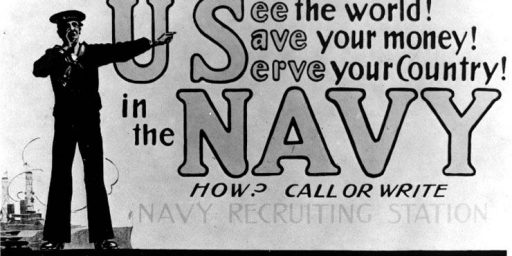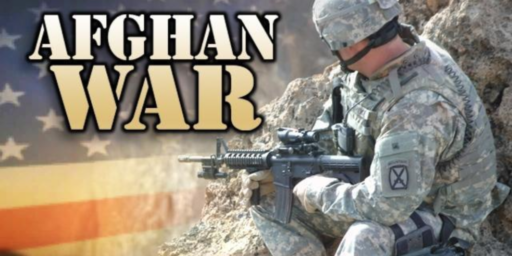Iraq Withdrawal Logistics (Updated)
Phil Carter draws my attention to a report by Lawrence Korb and colleagues on the logistics of troop withdrawal from Iraq.
The study’s working assumption, that the Surge will inevitably fail and that withdrawal must commence immediately, is a political question that’s hotly contested. The military-logistical questions, though, are interesting in their own right.
Those who argue for a rapid and immediate withdrawal of U.S. forces have often been accused of adopting an unrealistic approach. This, we believe, is a misplaced critique. It is certainly possible to conduct a rapid withdrawal of U.S. forces, in perhaps as short a time as three months if the U.S. military (in the words of Iraq war veteran and military analyst Phillip Carter) were to effectively conduct an “invasion in reverse.”
If the U.S. Army was ordered to withdraw to Kuwait, they could do so quickly and relatively safely. Such an exit, however, would sacrifice a significant amount of equipment and create an instantaneous political and security vacuum similar to that created by the initial overthrow of Saddam Hussein. While this option is certainly feasible, we do not believe that it is the best course of action.
Yet we must also caution that if the United States does not set a specific timetable our military forces and our overall national security will remain hostage to events on the ground in Iraq. Worse still, a startling new development such as the assassination of the Ayatollah Sistani or a large sectarian attack leading to an all-out civil war could well compel our forces to withdraw in as little as three months. We need to start planning now for redeployment.
Those who argue that a withdrawal will have to take place over a number of years, perhaps as many as four, base their analysis on the time it takes to complete a meticulous extraction and dismantling of all U.S. equipment and facilities. As this report will demonstrate, we believe that such an extended timeline increases the danger to U.S. forces and is not cost-effective from a logistical standpoint even though such an approach would presumably result in a complete extraction of all U.S. equipment.
The essential logistical point of disagreement between these approaches centers on the value placed on the equipment that is to be withdrawn. We believe that all essential, sensitive, and costly equipment must be safely withdrawn, but taking out non-vital equipment and the meticulous dismantling of certain facilities with no military value should not be an obstacle to redeploying our troops out of harm’s way in Iraq and back into the fight against terrorism, which national security experts from across the political spectrum agree threatens the United States more than at any time since 9/11.
A phased military redeployment from Iraq over the next 10 to 12 months would begin extracting U.S. troops from Iraq’s internal conflicts immediately and would be completed by the end of 2008. During this timeframe, the military will not replace outgoing troops as they rotate home at the end of their tours and will draw down force and equipment levels gradually, at a pace similar to previous rotations conducted by our military over the past four years. According to a U.S. military official in Baghdad involved in planning, a withdrawal could take place safely in this time period.
The report envisions a small constabulary force left behind in the Kurdish region as well as Navy and Marine assets offshore.
The relatively short timeframe is one scoffed at by many other experts, including some who opposed the war from the outset like Anthony Cordesman.
“The faster you move out, the more you have to leave behind or destroy,” said Mr. Cordesman of the Center for Strategic and International Studies. “There’s no ideal.”
Voters and political candidates, he says, are looking for a quick-exit “fantasy.”
“If you blow everything up, take the critical vehicles and get the people out, you can do it in a month. But why?”
With individual missiles costing $100,000 or more and armored Humvees about $380,000, the staggering value of materiél demands a longer, more complete withdrawal, Mr. Cordesman said. “You can leave an awful lot of things behind. But that borders on the insane.”
Here’s an even more pessimistic assessment:
Troops concentrated in convoys that are transporting huge quantities of supplies out of Iraq make tempting targets. In the south, British forces have been attacked by militants as they pull back.
“We’re probably going to get stuck fighting our way out,” said Stephen Biddle, a senior fellow at the Council on Foreign Relations, especially in a rapid withdrawal. Mr. Biddle gives the current increase in troop levels a limited chance of successfully stabilizing the country, but it will take perhaps two years, with more casualties in the meantime. Hence the calculation: Withdraw with casualties now, or risk a better exit in a few years? How great is that risk?
And how likely is that outcome?
Phil had an interesting piece in Slate back in May discussing some of these issues. He points that the Army is already planning to replace the older, unarmored Humvees and that the cost of some of the other equipment is an acceptable write-off. I would agree on that score, especially since one would have to factor the enormous additional cost of an extended presence in Iraq into the cost-benefit analysis.
The main questions remain political rather than logistical: What can we accomplish if we stay? What effects will a rapid versus slow withdrawal have on the internal dynamics in Iraq? How many Iraqis do we take with us when we leave?
Update (Dave Schuler)
Another perspective on withdrawing from Iraq from Baseline Magazine:
If the U.S. decides to pull out of Iraq, its military forces won’t exit immediately—they can’t. Moving 160,000 troops and tons of equipment is a logistics process that, even if done right, will take two years.
A lengthy, detailed exploration of the subject. This battleship ain’t stoppin’ on a dime.






Are any of the authors of this report Iraq or Middle East specialists? The report appears to make the tacit assumption that a withdrawal would not take place under combat conditions. Pat Lang, who opposed the invasion of Iraq and knows more about Iraq than the authors of the report, disagrees.
This is true. And the fact that we’re still debating whether we should build this sort of contingency plan now, rather than having built it 3 years ago, is pretty damning evidence of a total lack of serious strategic thought (or competence for that matter) on the part of anyone involved in the Iraq war effort, from CENTCOM staff all the way up to the President.
Problem with this whole line of thinking is the surge is working. Anbar, the lost province, is now working with our forces. The signs must be nearly everywhere as an antiwar Democrat for Washington State returned from a visit to Iraq saying we are winning. There are those who will claim defeat right up until the final victory, but polls show America does not really want to lose another on. This in spite of the politics of the left.
Cordesman did not oppose the war from the outset.
“I would say that personally and with great reluctance I would say that we probably do have to fight this war. I have simply watched what has gone on in Iraq too long and I think that what has been uncovered, provided in the British white paper and to a lesser degree the new CIA white paper documents far more of an active process of proliferation than people seem to realize.”